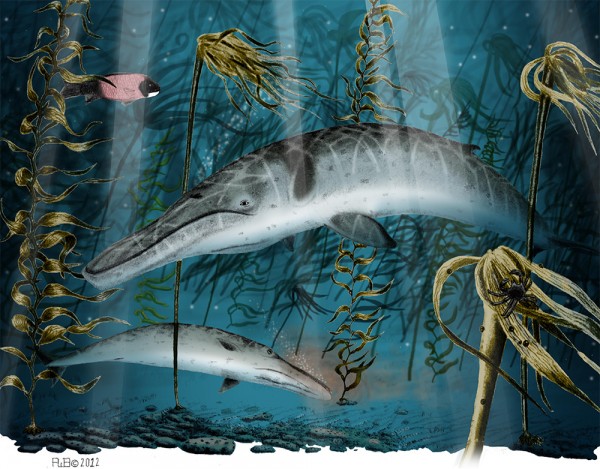Alumni Joe El Adli has published his research on fossil baleen whales that he started with his undergraduate thesis done here in the department and at the San Diego Natural History Museum. In a major portion of the manuscript, he described a new species of whale, which he named after his coadvisor Jared Morrow. Faculty, friend and colleague Jared Morrow lost his battle with cancer on Oct. 7, 2010.
ACKNOWLEDGEMENTS
The authors would like to recognize the life and accomplishments of Jared R. Morrow for his contributions to sedimentary geology and for his tireless efforts to educate a new generation of geologists and palaeontologists. Jared’s endeavours to help his students in any way possible did not go unnoticed or unappreciated. He is greatly missed. The authors would like to thank L. G. Barnes, G. Calvano, R. A. Cerutti, J. Pitt, B. O. Riney, and P. J. Sena for collection of the invaluable specimens of H. morrowi examined in this study. D. J. Bohaska, M. B. Goodwin, R. J. Hilton, P. A. Holroyd, C. W. Potter, N. D. Pyenson, and K. A. Randall are thanked for allowing us to study specimens under their care. Scripps Mercy Hospital is thanked for helping to produce CT images of UCMP 124950 and SDNHM 65781. The authors benefited from discussions with A. C. Dooley, E. G. Ekdale, D. C. Fisher, R. E. Fordyce, J. H. Geisler, P. D. Gingerich, F. G. Marx, C. H. Tsai, M. D. Uhen, and J. A. Wilson. This study was partially funded by an NSF grant to T. A. Deméré. Finally, the authors would like to thank S.J. Godfrey and an anonymous reviewer for their thorough and constructive comments on this manuscript. R. W. Boessenecker was supported during a portion of this study by a University of Otago Doctoral Scholarship. J. J. El Adli was partially supported during a portion of this study by a University of Michigan Department of Earth and Environmental Sciences Departmental Fellowship.

left is a sheephead (Semicossyphus sp. Ayres, 1854), known from otoliths and isolated teeth from the San Diego Formation (illustration by Robert Boessenecker).
Herpetocetus morrowi (Cetacea: Mysticeti), a new species of diminutive baleen whale from the Upper Pliocene (Piacenzian) of California, USA, with observations on the evolution and relationships of the Cetotheriidae
Joseph J. El Adli1,2, Thomas A. Deméré1, Robert W. Boessenecker3,4
1Department of Paleontology P.O. Box 121390, San Diego Natural History Museum, San Diego, California, USA
2Department of Earth and Environmental Sciences, University of Michigan, Ann Arbor, Michigan, USA
3Department of Geology, University of Otago, Dunedin, New Zealand
4University of California Museum of Paleontology, University of California, Berkeley, California, USA
Abstract
The extinct edentulous mysticete family Cetotheriidae historically has been viewed as a notoriously paraphyletic group, and only recently have rigorous studies been executed to rectify this issue. These problems do not necessarily just stem from lack of phylogenetic analyses, but are in part because of a general lack of complete specimens, poor descriptions of taxa, and long-lived taxonomic instability issues. The fossil mysticete genus Herpetocetus is a poster child of these problems as it is primarily only known from a few relatively incomplete and poorly described specimens. A new species of Herpetocetus from the upper Pliocene of California, Herpetocetus morrowi sp. nov., provides an archetypal model for the genus based on a multitude of well-preserved specimens. These specimens reveal a diminutive mysticete characterized by an elongate rostrum and roughly quadrate cranium. A mosaic of primitive and derived features preserved in this new species underscores its potential value in helping to resolve a number of taxonomic and phylogenetic problems. The occurrence of specimens assignable to juvenile through to mature adult individuals provides a basis for investigating ontogenetic changes. Functional analysis of the unusual craniomandibular anatomy of H. morrowi suggests a limited degree of mandibular gape and an enhanced capacity for longitudinal rotation of the dentary, features that support a hypothesis of suction feeding convergent with that of living grey whales. A phylogenetic analysis provides support for recognition of a redefined and monophyletic Cetotheriidae and Herpetocetinae, and also serves as a basis for evaluating the recent proposal that the pygmy right whale (Caperea marginata) is a living cetothere. Morphological features of Herpetocetus morrowi, including features of the cranium and petrosal, suggest that a number of the purported synapomorphies supporting a Caperea−cetothere grouping are either symplesiomorphies, nonhomologous features, or are highly variable.
 El Adli, Joseph J., Deméré, Thomas A., Boessenecker, Robert W., Herpetocetus morrowi (Cetacea: Mysticeti), a new species of diminutive baleen whale from the Upper Pliocene (Piacenzian) of California, USA, with observations on the evolution and relationships of the Cetotheriidae, Zoological Journal of the Linnean Society, 2014, 170, 400–466., doi: 10.1111/zoj.12108
El Adli, Joseph J., Deméré, Thomas A., Boessenecker, Robert W., Herpetocetus morrowi (Cetacea: Mysticeti), a new species of diminutive baleen whale from the Upper Pliocene (Piacenzian) of California, USA, with observations on the evolution and relationships of the Cetotheriidae, Zoological Journal of the Linnean Society, 2014, 170, 400–466., doi: 10.1111/zoj.12108
Watch Joe’s Thesis Defense
A new species of the extinct baleen whale genus Hepetocetus (Cetacea, Herpetocetinae) from the San Diego Formation of San Diego, California.
Joe El Adli
B.S. Candidate Department of Geological Sciences San Diego State University
Advisor Dr. Tom Deméré and Dr. Jared Morrow

